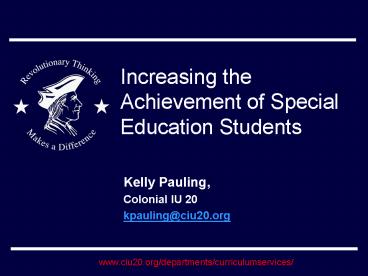Increasing the Achievement of Special Education Students - PowerPoint PPT Presentation
1 / 31
Title:
Increasing the Achievement of Special Education Students
Description:
Colonial IU 20. kpauling_at_ciu20.org. www.ciu20.org/departments/curriculumservices ... building enrollment overall enrollment trends against identification of special ... – PowerPoint PPT presentation
Number of Views:27
Avg rating:3.0/5.0
Title: Increasing the Achievement of Special Education Students
1
Increasing the Achievement of Special Education
Students
- Kelly Pauling,
- Colonial IU 20
- kpauling_at_ciu20.org
2
Data, Design, Delivery
- What data is needed?
- How might the design be developed?
- How would the implementation look?
3
Data
- How would you describe the students targeted in
the improvement plan? - Describe your current system of intervention.
- What percent time does the average special needs
student in regular education? - Provide an analysis of district/building
enrollment overall enrollment trends against
identification of special education students.
4
Characteristics of Students
- Low reading achievement
- Low motivation
- Slow learners
- Do not generalize well
- Do not transition well
- Memory problems etc.
- Sample list developed by an intermediate school
improvement team targeting improvement for
special education students.
5
How does your school improvement plan meet the
needs you have identified?
6
of Instructional Minutes
7
Is there strong, observable evidence that the
instructional program is aligned to state
standards and assessments?
Foundational Question 1
8
IEP Goals and objectives are aligned to standards
and assessment anchors. Teachers negotiate
individual student needs with grade-level
expectations using the PSSA test blueprint to
determine educational priorities.
A YES Response
9
Is there strong, observable evidence that all
students have access to challenging, on-standard
curriculum and rigorous assignments?
Foundational Question 2
10
Students with special learning needs maintain a
portfolio of standards-based work. Instructional
aids and scaffolds help students bridge the gap
between instructional level and grade-level
expectations.
A YES Response
11
Is there strong, observable evidence that the
effectiveness and experience of the teacher are
matched to the needs of students as equitably as
possible?
Foundational Question 3
12
A YES Response
- Could include
- HQT
- Co-teaching
- Specialized training
13
Is there strong, observable evidence that school
staff use frequent and timely standards-aligned
formative assessments to monitor and adjust
instructional practices?
Foundational Question 4
14
All students including special education students
are monitored quarterly using 4Sight. Data is
reviewed to determine effectiveness of
interventions and instructional strategies.
Special education students are progress monitored
weekly or monthly depending on the goal.
A YES Response
15
Is there strong, observable evidence that
students at risk of falling behind receive
accelerated interventions designed to close their
learning gap rapidly?
Foundational Question 5
16
A pyramid of intervention offers increasingly
more intense programs designed to accelerate
learning. Students are assessed to determine the
appropriate intervention for their needs.
Interventions are monitored frequently for
implementation fidelity. In addition, the regular
education program reinforces core reading
strategies in all classes throughout the day.
A YES Response
17
Pyramid of Intervention
- Very
- Intensive
- Intervention
- Intensive Intervention
- Moderate Intervention
- High Leverage Instructional Strategies for all
students
18
Example of a Pyramid of Intervention
- Wilson Reading
- Corrective Reading
- REWARDS
- Read 180
- Reading Apprenticeship
Literacy example from an intermediate school.
19
Is there strong, observable evidence that
professional development is linked directly to
the schools instructional priorities is
standards-based and is differentiated to meet
the continuous learning needs of school staff?
Foundational Question 6
20
All teachers engage in professional development
to deepen their understanding of standards and
high leverage instructional strategies.
A YES Response
21
Is there strong, observable evidence that school
staff and administrators engage in scheduled,
evidence-based collaborative inquiry about their
professional practice and student learning
progress?
Foundational Question 7
22
Special education teachers work with content area
teachers to analyze student data and collaborate
on possible solutions for identified issues, and
examine student work in relation to standards.
A YES Response
23
Is there strong, observable evidence that
struggling teachers, staff, and administrators
receive timely, effective support and
intervention?
Foundational Question 8
24
Teachers struggling with implementation on
priority areas are identified and given
additional support.
A YES Response
25
Is there strong, observable evidence that a
significant proportion of the schools resources
(e.g., money, people, time) is directed toward
strategies that enhance professional practice and
the core instructional program?
Foundational Question 9
26
Staff development and resources required are
focused and tied to instructional priorities.
Teachers struggling with implementation are
identified and given additional support.
A YES Response
27
Is there strong, observable evidence that the
principal is proactively involved in the
planning, supervision, and monitoring of the
instructional program and student learning?
Foundational Question 10
28
All teachers are held accountable for
implementation of high leverage instructional
strategies. Building leaders and teachers engage
in frequent walk-throughs to provide feedback.
Data analysis meetings are conducted regularly to
monitor implementation.
A YES Response
29
Design Considerations
- Assessment to drive interventions
- Fidelity of the model
30
Design Considerations
- Paradigm shift needed for increased achievement
for special education - Creating a systems approach to increasing the
achievement of special education students. - Increased collaboration between special education
regular education
31
Design Considerations
- Identifying tools to bridge gaps
- Developing perseverance Focused staff development
- Developing a common language for core
instructional strategies































